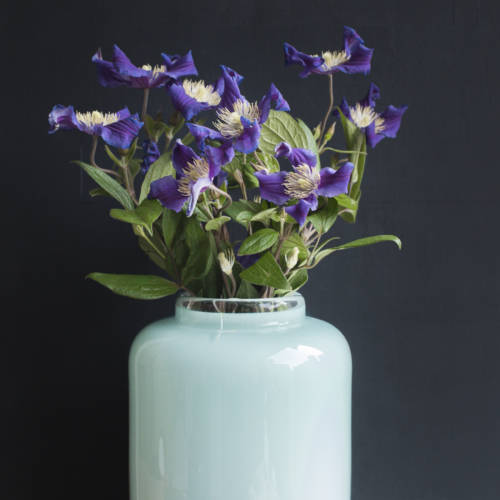
Ask Ella: Give Bouquets A Wild Charm With Clematis
Ask Ella is a recurring Garden Collage feature where we ask our in-house florist, Ella Stavonsky, about floral design– including the history of, origin, and maintenance that goes into some of the most intriguing flowers on the market today. This column is dedicated exclusively to common and rare varieties of flowers you’re likely to find at your local market. This week, we spotlight clematis, a delicate purple flower that adds austere beauty to any arrangement.
***
Clematis has a certain tendresse about it– the coiling vines, the thin leaves, the velvety petals. It is a classically-beautiful flower emblematic of country gardens, restrained but still a little wild. The term ‘clematis’ itself refers to a genus in the buttercup family; some varieties have a specific name– like traveller’s joy (Clematis vitalba), virgin’s bower (Clematis viticella), leather flower (Clematis pitcheri), and vase vine (Clematis viorna)– but by and large any type of clematis simply goes by the clematis name.
In bouquets, the climbing vine adds a touch of spontaneous beauty. “Greens offset clematis beautifully, especially trailing greens, like jasmine and passion ivy, or unusual greens, like ferns and baby green hydrangea,” Ella tells us. “They also look good mixed with other purple flowers, like lavender roses.” Beyond using them in standard vase bouquets, clematis also looks stunning trailing off tables in runner centerpieces (for those who dream of decor).
While clematis is widely considered temperamental, it can last up to two weeks when properly cared for. When purchasing (or clipping from your own garden!), be sure to look for buds that aren’t completely open and get them quickly into water. While clematis is widely considered temperamental, it’s actually a pretty hardy cut flower and can last up to two weeks when properly cared for. On her best practices, Ella advises: “Warm water as soon as you get them home. When you’re ready to add them an arrangement, scratch or split the bottom of the stems, like you do with hydrangeas.”


































